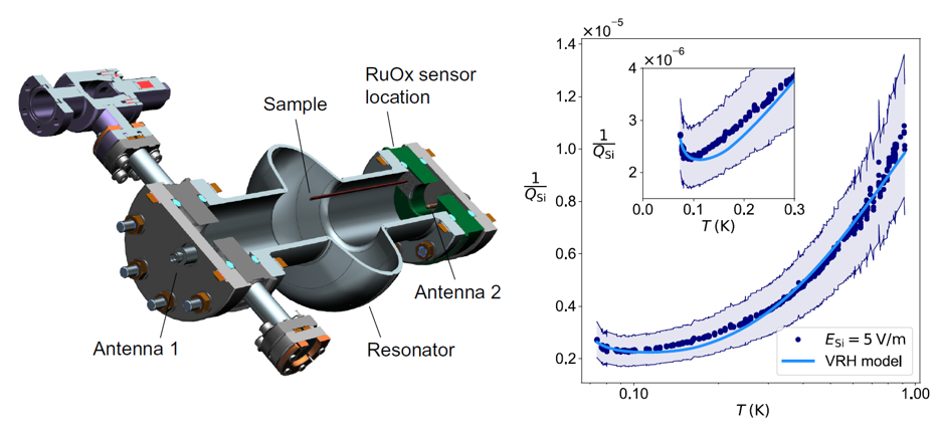Uncovering loss mechanisms in high-resistivity silicon for quantum devices with parts-per-billion precision
New insights into the origins of loss in a commonly used superconducting qubit substrate help to develop mitigation strategies for improved qubit coherence.
The Science:
By using ultra-high-quality factor electromagnetic resonators, we measure the loss tangent of high resistivity and intrinsic silicon with parts-per-billion precision. We find that the loss tangent is ten times greater than previously reported and exhibits an unexpected variable-range hopping conduction behavior as a function of temperature.

The Impact:
This work advances the understanding of dielectric losses in high-resistivity silicon, a critical material in superconducting quantum devices, by providing precise measurements at millikelvin temperatures and revealing unexpected loss mechanisms. These findings enable more accurate modeling and optimization of materials to further enhance qubit coherence times.
Summary:
This study reports the first direct measurement of the loss tangent of high-resistivity silicon in the millikelvin temperature range, utilizing a high-quality-factor superconducting niobium resonator. Silicon is widely used in superconducting quantum devices, and understanding its loss mechanisms is essential for advancing qubit coherence and quantum performance. The measured loss tangent is found to be an order of magnitude higher than earlier estimates based on indirect measurements.
The research also reveals a nonmonotonic temperature dependence of the loss tangent, with a minimum at approximately 80 mK, and a field-dependent dissipation behavior inconsistent with the conventional two-level system (TLS) model. These phenomena are attributed to variable-range hopping (VRH) conduction, a mechanism where localized electrons hop between states near the Fermi level, particularly in the presence of an electric field. By introducing a phenomenological model based on VRH, this work provides a framework for interpreting these findings and points to previously overlooked dissipation channels.
Contact:
Daniel Bafia – dbafia@fnal.gov
Focus Area:
Materials
Institution:
Fermi National Accelerator Laboratory
Citation:
M. Checchin, D. Frolov, A. Lunin, A. Grassellino, and A. Romanenko, Measurement of the low-temperature loss tangent of high-resistivity silicon using a high-Q superconducting resonator, Phys. Rev. Applied 18, 034013 (2022).
DOI: https://doi.org/10.1103/PhysRevApplied.18.034013
Acknowledgment:
This material is based upon work supported by the U.S. Department of Energy, Office of Science, National Quantum Information Science Research Centers, Superconducting Quantum Materials and Systems Center (SQMS) under Contract No. DE-AC02-07CH11359.
